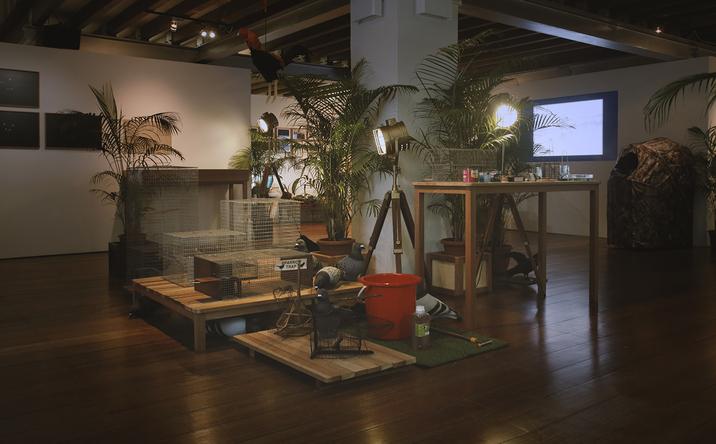-
From Current Issue
-
- Editor’s Letter Fire in the Heart
- Reviews I Gusti Ayu Kadek Murniasih
- Reviews 11th Seoul Mediacity Biennale: “One Escape at a Time”
- Dispatch Networked China
- One on One Monira Al Qadiri on Yukio Mishima
- Essays The rise of independent art spaces in pandemic-era Shanghai
- Features Tuan Andrew Nguyen
- Table of Contents
- Web Exclusives
- Archive
- Subscribe

R
E
V N
E
X
T
ROBERT ZHAO RENHUI speaking at the performance-lecture and exhibition “The Nature Museum” at 72-13, Singapore. Photo by Foong Yuen Ting. Courtesy the artist.
Devised as a collaboration between artist Robert Zhao Renhui and playwright Joel Tan, the performance-lecture and exhibition “The Nature Museum” was a theatrical venture into museological waters. By adopting the roles of archivists of the Institute of Critical Zoologists, Zhao and Tan took their audience on an informal tour, encouraging one to drift in and out of attention. While the performance was not devised with charismatic delivery in mind, one could not help but glide within the dense network of narrative channels, which were rooted in a thoughtful, dark absurdity that seemed effortless for the pair to generate.
For those familiar with Zhao’s artistic practice in the medium of photography, the theatricalized museum was designed to suspend reality, accommodating visitors in the story that unfolded. The performance-lecture sustained a light tone, steering away from didacticism with considered dramaturgy, wherein they spoke with images and objects (evoking puppetry), rather than for them (as in performing with props). When narrating one chapter of the tour, “The History of Birds,” Zhao briefly played a sales representative for bird traps, passionately describing and demonstrating the use of these human machinations. Zhao’s performance may not have been intended to be cruelly funny, but it brought to mind the fraught relationship between humans and animals—trapping animals is one way to study their behaviors, placing humans in a position of mastery over other living things.
One illuminating narrative thread follows the fictional amateur naturalist Francis Leow, whose penchant for anecdotes and poetic waxing excluded him from the scientific community. Tan’s moving story-telling relayed a series of rejections, whims and passions from the Francis Leow Archives, which compelled the audience to sit attentively around the raconteur. Leow’s preoccupations include failed projects like a proposal to government agencies to transform the undersides of vehicle flyovers into artificial caves—with stalactites and all—“to mitigate the displacement of bat populations” as a result of mangrove clearing. In the tale, Leow’s interest in bats began with a passion for durian, of which the cave nectar bat is the sole pollinator. Biography flirted with rumor as Tan told the audience that Leow worked clandestinely to build day roosts for these flying mammals, only to be discovered after his death. Francis Leow’s mission resonated with the raison d’être of the Institute: to tell stories of nature and culture with an unassuming attitude.
ROBERT ZHAO RENHUI, photograph from the “Mynas” series, 2016, matt diasec in frame, 40 × 60 cm. Courtesy the artist.
Coursing through the tour, one heard connected stories of the epistemic hubris in colonialism, the looming threat of ecological destruction and the improvisation by animals that must adapt to rapidly shifting conditions—acts of agency that unravel anthropocentric discourse of humanity’s role as saviors of the environment. In “The History of Birds,” what began as the faint chirping of mynahs in the background turned into an overwhelming deluge of birdcalls, with projected photographs from Zhao’s “Mynas” series (2016) that captured impressions of the haunting, sinister presence of the birds in roost. The moment was a significant disruption of the tour’s otherwise playful tone, whereby nature was portrayed as a body of knowledge that withdraws as one labors to unearth details. Although implicitly phrased, “The Nature Museum” proposed that humans and nature are ontologically equal.
The objects on display were engaging in their own right, even without Zhao and Tan’s verbal exposition. A meticulous selection and arrangement ensured that they carried their own narrative force. On the study table of Francis Leow lay taxidermy insects, photographic and scientific equipment, a statue of koi fish for good luck, orchids encased in resin and plastic durians, which altogether bore witness to the Institute’s immense scope of research.
As the quivering shadows of palm leaves obfuscated our view of archival photographs from the fictional Coast Exploration Society, reality set in: what was assumed to be a parody of an infomercial for “Enta Bird King, Bird Repellent (EM-149K)” was an actual promotional video of a chemical mixture made to fend off birds. With the sweet suspension of disbelief weighed down by contingent truths, “The Nature Museum” crafted a reality stranger than fiction.
Installation view of the “Experiments” segment in THE INSTITUTE OF CRITICAL ZOOLOGISTS’s “The Nature Museum” at 72-13, 2017, commissioned by the Singapore International Festival of Arts (SIFA). Courtesy the artists and SIFA.
“The Nature Museum” is on view at 72-13, Singapore, as part of the Singapore International Festival of Arts until September 8, 2017.
To read more of ArtAsiaPacific’s articles, visit our Digital Library.









